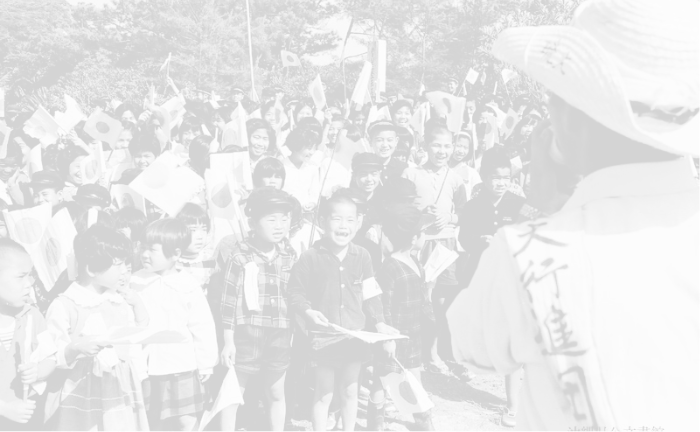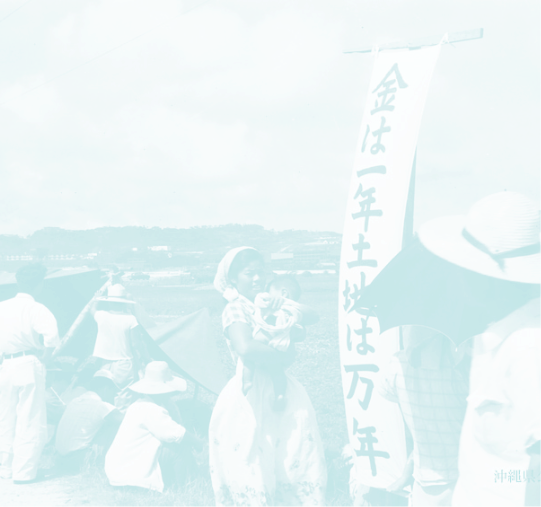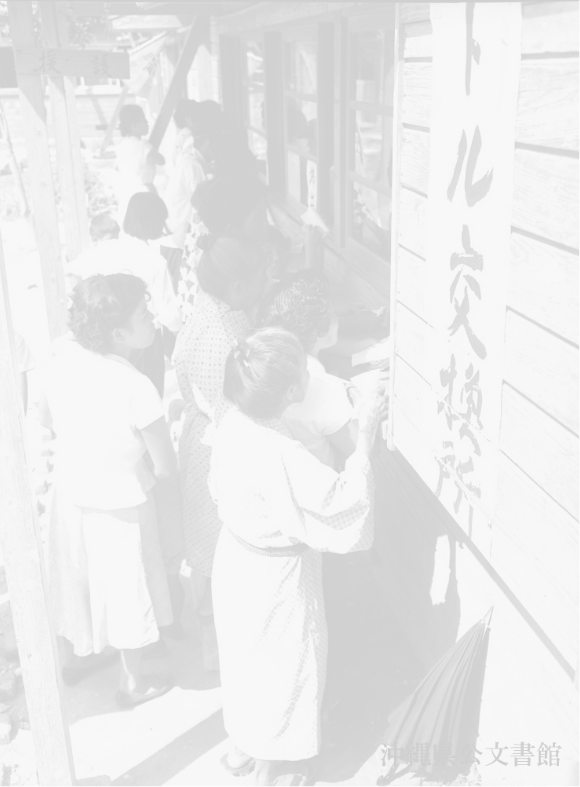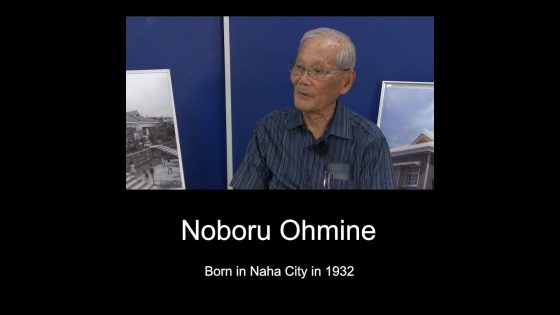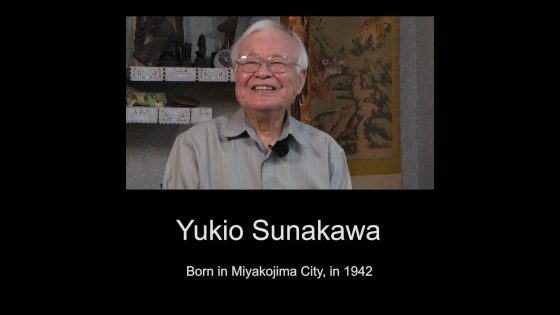
Post-war Art Education
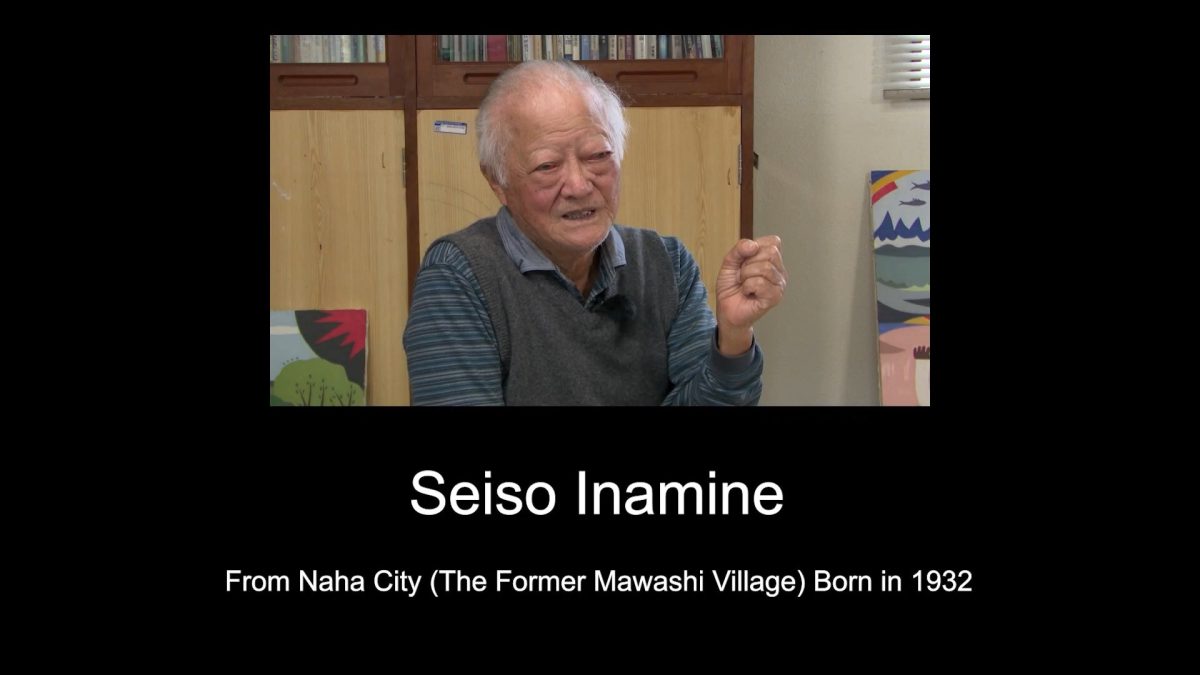

- Born in 1932
- Seiso Inamine
Timeline
| 1937 |
Born in Uenoya, former Mawashi Village (now Naha City).
|
|
|---|---|---|
| 1944 |
In the 6th year of elementary school, he and his younger sister moved to Kumamoto as part of an evacuation of school children. The ship was in the same fleet as the Tsushima Maru.
|
|
| 1946 |
After returning to Okinawa from Kumamoto, he lived with his parents on Kumejima Island.
|
|
| 1947 |
Entered Kumejima High School in April, transferred to Itoman High School in May due to his father's job transfer, entered the newly established Naha High School in October, and joined the art club.
|
|
| 1955 |
Graduated from the Department of Arts and Crafts, Faculty of Letters and Science, University of the Ryukyus. Later studied at the Shinjuku Art Institute in Tokyo.
|
|
| 1956 |
Worked as an art teacher at Naha Junior High School. Then worked at Higashi Junior High School, Urasoe Junior High School, and other schools.
|
|
| 1972 |
Joined the University of the Ryukyus as a lecturer in the Faculty of Education.
|
|
| 1983 |
Professor, Faculty of Education, University of the Ryukyus.
|
|
| 1992 |
President of Okinawa Formative Arts Education Federation until May 2001.
|
|
| 2018 |
Received the Okinawa Prefecture Cultural Merit Award.
|
Story
Brief biography of the witness
As a college teacher and head of the Okinawa Art Association, he taught the younger generation and devoted himself to art education after the war.
He has produced and exhibited artwork for several years, also receiving various accolades for his creativity. Additionally, he has exceptional knowledge about Okinawa's post-war restoration, people's lives, post-war school culture, art programs, and Nishimui (art village).
From an evacuation site to his hometown in Okinawa
Returned to Okinawa from an Evacuation Site
I was told, “We've arrived in Okinawa and can already see Naha.” and I went up to the deck. The land of Okinawa as seen from the ship was a pure white. If it was in the Yanbaru area, it might have looked green. But when we approached Naha, Okinawa’s land was pure white. I was surprised because it seemed like the entire island had been stripped of its skin. When we arrived at the port of Naha, everyone was taken off the ship. I was also surprised because that was the first time I saw African Americans. They disinfected the children using a pure white chemical called DDT to kill any bugs. They loosened the belts of our pants and sprinkled it there. They also put it on our necks and rubbed it on our heads. When that was finished, everyone was loaded into the truck. I was told “Yes, go. “The destination of the truck was Innumi, Kubasaki, or another repatriation camp. People went there and if there was someone to pick you up, they would, but if there was no one to come for you, the camp would have become your temporary accommodation. In my case, my uncle came and took me right away.
At that time, my uncle lived in Ishikawa, so I went there too. My father, who was the principal of Hiyajo Elementary School during the war, and my mother, were on Kumejima. My grandparents were in Naha. His house was burnt down in the 10/10 air raid, so he rented an acquaintance’s house in Ameku. I had one older brother and he was a first-year student of Kenritsu Daiichi Junior High School. He was killed in battle along with other students as part of the student corps. Of the five members of my family who lived in Uenoya on the main island, my younger sister and I were evacuated as school children and fled to Yanbaru. My grandfather survived. My grandmother died of an illness and my brother died in the war. After I was taken in by my uncle, I was able to move from Ishikawa. My sister and I took a boat from Itoman bound for Kumejima and went to our parents.
Post-war educational environment and high school life
Entered Kumejima High School Then Entered Itoman High School
My father was in the principal’s residence at Hiyajo Elementary School, so I lived there with my parents and younger sister. That’s my family. At that time, the school had elementary classes up to 8th grade. Elementary school 7th and 8th grade students were able to take high school entrance exams. I took the entrance exam for Kumejima High School. At that time, Kumejima High School was a branch school of Itoman High School, and students up to the first and second grades were located on Kumejima, and from the third year onwards, they went to the main school, which was Itoman High School. The school’s hats and emblems were therefore all the same as those at Itoman High School. My father became the principal of Kora Elementary School in Oroku, so we moved to Oroku as well. One day, I went to Itoman to transfer schools, and was looking for Itoman High School. I saw some Itoman high school students, so I asked them, “Where is Itoman High School? “They said, “Are you serious?” and I wondered why. They said “You wearing an Itoman High School hat But don't know where Itoman High School is? School has already started “I said, “Actually, I'm a student at Kumejima High School.” “I'm transferring to Itoman High School and would like to complete the process. “So he understood and told me the location.
At that time, there were a number of high schools including Itoman High School, Chinen High School, Shuri High School, and Ginoza or Maehara High School. The US military divided the land into areas such as the Chinen District and other districts. Then high schools were built one by one. At that time, Naha was not yet habitable, so there was no high school in Naha. After that, Naha High School was built on the site of the prewar Tenpi Elementary School. It was around October in 1947.
Student Life
Itoman and Oroku were about 8km apart. There was a place called MP House near Akamine in Oroku, and US military trucks came to Itoman one after another in the morning to bring military workers from Itoman to Naha. So they took them from Itoman to Nahant the morning, the truck was empty, so we all took advantage of it and went to Itoman. So I went to school by truck. On the way back, the truck would drop off military workers in Itoman and return to Naha empty. So I was given another ride and could return to Oroku. Itoman High School had a tent for a school building, so of course there were no desks or seats. I found a box and sat on i.e. didn't have a desk, so I was writing with a drawing board hanging around my neck.
Entered the Newly Established Naha High School
At that time, the entire city of Naha was a burnt field. If you look at the city from around what is now Sogenji Temple, you could see the buildings of Tenpi Elementary School and Uenoyama Junior High School, but it seemed like there was nothing else. There was no uniform, so everyone was wearing random clothes from the US military. There were no designated hats either, so everyone wore different hats. The only thing they had in common was a hat with two white lines wrapped around it and an emblem. Everything else was random, and there were quite a few surplus leather shoes from the US military. However, they were too big and I couldn't wear them. If I found a small leather shoe, it would be a treasure. The only shoes available were those that had 4 to 5 centimeters of space in the front. Everyone wore shoes like that. Before long, wooden clogs became popular. Using a standard 2 x 4 piece of lumber, I was able to make wooden clogs by cutting it. There were shops selling wooden clogs. Both men and women were all wearing wooden clogs.
Joined Art Club and Started to Study Art
At that time, the future paths for high school students was not bright at all. At that time, even if you graduated from high school,
your only option was to become a military worker. At that time, an art teacher named Kanpei Shimada started an art club. Even though I didn't really like art or was good at it, I joined the club because I had nothing else to do. I didn't have any paint, so I just did pencil sketches every day. Mr. Kanpei was good at praising children, so everyone did their best. Thanks to that, Naha High School produced many artists,
including students younger than me. My mother sold used clothes at the market called “Marukuni Market” I remember she bought me some paints
because I was in the art club at the time. The amount I used was about the size of a soybean, and I carefully used it little by little. I didn't have any drawing paper, so I went to the garbage dump and found yellow paper from the US military. It wasn't ordinary thin paper, but yellow drawing paper. I used to draw pictures on it. About a year later, I was able to obtain drawing paper. When I drew on that paper, it seemed to glow for some reason. Until then, the paper I was using was yellow
and had a colored base from the beginning, so I remember thinking it would be difficult to draw on white paper.
Living in an area that still bears the scars of war
Moved Due to Father's Job Transfer Around Asato Area
In the place which is the current Naha Shintoshin, there were US military tanks everywhere. There were many tanks with broken caterpillars, tanks with holes in the middle of their bodies that had been blown up by mines, and many unexploded bombs. While everyone was working in the potato fields, an unexploded bomb was discovered. People brought all the unexploded bombs and piled them up in the community center. The place was diagonally across from my house. Unexploded bombs were piled up as tall as a human. When the amount was large enough to fill the back of a truck, someone contacted the US military and had them come and pick up the unexploded bombs. But the number of unexploded bombs soon increased again. Even if there were a lot of unexploded bombs in front of us, no one was scared. That’s what life was like. Tank remains were scattered around the place. Also, beyond the mountain on the Naha side behind the village, there was a US military facility. There were a lot of African-American soldiers. At night, they often came to the village to catch women. Everyone was scared of that, so we let people know, “The African-American soldiers are coming!” and the young men all whistled and chased them away with sticks and stones.
At that time, my father was the school principal. But he made wooden clogs with 2 x 4 lumber. Also, my mother made candy with brown sugar. They did that kind of work as side jobs to survive. They also sold awamori alcohol. They opened a small store and sold some products.
Attended college to become an artist.
Thoughts about Aspiring an Artist
Okinawa was socially and economically exhausted after the war. During this time, there was the idea that the younger generation should do their best for the reconstruction of Okinawa. However, becoming an artist meant running away from that. So in that sense, I felt like a burden. On the other hand, I thought that if I only drew good pictures, I would be recognized by the world. I thought that the people from the US who established the Department of Arts and Crafts at The University of the Ryukyus were at a high level. If it were Japan, people wouldn’t establish a department of arts, because you can't make a living. They rather would establish something that was useful for the economy and society, to survive. I think the U.S. did a good job of that.
Entered the Department of Arts and Crafts at the University of the Ryukyus
At first I thought, “I don't need to study to draw. “So I didn't plan on going to the University of the Ryukyus, but my father asked me to go to university and get a teaching license. He said “Whether or not you become a teacher, you should go and study. “I didn't really disagree with him, and I also had a desire to learn, so I started at the University of the Ryukyus.
But in art class, we just drew cubes every day. There were no plaster busts, just drawings on paper with a pencil, so it was no different from high school. Then, towards the end of the first semester, the copper Venus bust statue arrived. It was dented as if it had been eaten by insects, but the students were overjoyed. I saw a plaster bust for the first time. We drew it with charcoal, but not everyone had that experience. After a while, a company started selling charcoal and other art supplies. I found out at that time that there was a way of drawing with long, thin pieces of charcoal. It would have been difficult to send a child to Tokyo to study at that time for a normal family economic situation. If people in Okinawa wanted to study rather than go into military work immediately after graduating from high school, people had no choice but to go to the University of the Ryukyus. I think the level of the classes was quite low. There were no textbooks. It was like an extension of studying in high school, and there were no slides in art class. The teacher gave lectures about colors using the textbook, but it contained only a few black and white photos. In a class, I could hear the logic, but the impression I received from the paintings was only imagined, and I didn't actually understand it.
Studied Under the Painters of Nishimui Art Village
Back then, I used to go to the teachers’ houses at Nishimui Art Village. A younger student Jishu Onaga often went to Seikichi Tamanaha’s house, so I followed him. I didn't have any information about art, so I wanted to hear a lot about what the teachers were like when they were young. I didn't have access to a lot of art books, so back then there were many people who went to where the teachers were to hear various stories about what they studied. I also often went to Mr. Tamanaha's place with Jishu. So, in other words, the only way to get information about the art in mainland Japan was through the teachers.
Studied for One Year at an Art Institute in Tokyo
In Tokyo, I went to Shinjuku Art Institute. There, I also drew nude women. The institute was located just inside the current location of Kabukicho. There was an independent exhibition held by a Communist Party called Japan Independent, and I submitted two small drawings to intuit wasn't that the pictures were good or bad, but around that time I began to think that instead of following European and American trends, I should create pictures that were uniquely Japanese. Although those paintings no longer exist, I remember drawing a flat picture with no shadows. Those paintings were like the origin of the paintings I do now.
Dual Role as a Teacher and a Painter
Dual Role as a Teacher and a Painter
Back then, I was so busy that I couldn't go home at 5pm, so it was always around 6pm.After I got home and ate, it was almost 9pm.I continued to draw for about two hours from 9pm until 11pm.After all, I thought I wanted to become a painter, so in order to do that, I decided to use the time after 9pm for that purpose. My works were pictures that I could imagine and draw without looking at the actual object, so I could keep drawing. I was doing it as an extension of a realistic painting. I could draw realistic pictures at night, but it was hard to see colors, resulting in only shadows. Moreover, the lighting back then was different than it is now, and the colors of the paint might have looked a little different. People who paint so-called realist paintings don't paint at night. In my case, it's the kind of drawings where I just draw what I think in my head one after another, allowing me to draw without the effect of night or day.
From Junior High School to High School Became a University Instructor
When I was a junior high school teacher, there was a teachers' exchange system, where people would go from the Naha area to another area and come back after working for two years. I had to go back to Naha Junior High School, which was my previous school, but I wanted to go to the smallest school in the Naha area. When I asked where the smallest school was, it was Urease Junior High School. I made the request and I was assigned there. At school, the principal gave a lecture, and as part of that, he said “Study hard and become a driver or an interpreter. “I once thought, maybe he should talk about something a little more ambitious.
In the design department of Okinawa Technical High School, there was a fellow student from the University of the Ryukyus called Chotei Kimura, and Jishu Onaga also worked there, so they invited me to come to their school. So I moved from Urasoe Junior High School to the design department at Okinawa Technical High School. At that time, the design department had just been established, which was an undeveloped field. Like when we were the first students at Naha High School, I believed that students would grow depending on their teacher's ability. So we taught classes that encouraged students' imagination. Jishu Onaga was about two years ahead of me, and he was teaching lectures because he was asked to. And then he started working at the University of the Ryukyus about a year earlier, and I was also in charge of classroom lectures at the University and taught art-related general education classes. Since about 100 people came to classes, I couldn't do practical classes, so I gave lectures.
Message to younger generations
Message to Younger Generations
As for the uniqueness of Okinawa, it may be true that it is unique, but it may not be true. I think Okinawa is unique. The language is different and there are many customs from Southeast Asia. Many things are different, aren't they? That is a good thing, and it's not something to be arrogant about. I don't think it's something to feel bad about. To put it very roughly, Okinawa is the most northern limit of Japanese ethnic groups influenced by Southeast Asia and overseas Chinese. And the southern limit of Japanese culture is Okinawa. Okinawa is unique in the sense that it is a mixture of the two. I don't think it's something to be arrogant about, but I don't think it's depressing either. Maybe we need to realize that.
What I Keep In Mind Most When Creating Art
In my case, to put it simply, I want to draw pictures that are interesting and fun to look at. This is the basic idea. The question was then “What kind of pictures should I draw? “As time passed, there was something I realized much later. Japanese painters went to Paris and New York, to learn what's popular over there, and then imitate their style, saying that's what they drew over there. That is different from creating. In other words, we have to make something that is not popular overseas. For example, creating a work in Japan that has never been seen in Paris - this is creation. Having said that, I believe that creation is not something that can be done easily, like catching something that floats on air, but rather something like the soil that lies in one's roots.
What professor Kanemasa Ashimine said remains in my memory. He said Japanese forms are flat. “For example, for Shuri Castle, the longest side is the front and there is not much depth. However, buildings such as Western churches that appear in art books are vertically long. He gave such an example and said, “Japanese forms are flat. “When I was a student, I might have tended to interpret it as flatness is bad. That it has to be three-dimensional. I was taught to draw everything three-dimensionally, even plaster drawings, so I tended to interpret it as flatness is bad. But it is more that I am conscious that flat lines and three-dimensionality are equally wonderful, or rather, there is no top and bottom, and I make good use of the flatness within me. Maybe we should make good products in Japan instead of following trends in other countries, and that's why I'm drawing now.
RELATED
Involvement in Social Education Activities in Miyako after the War
- Born in 1942
- Yukio Sunakawa
